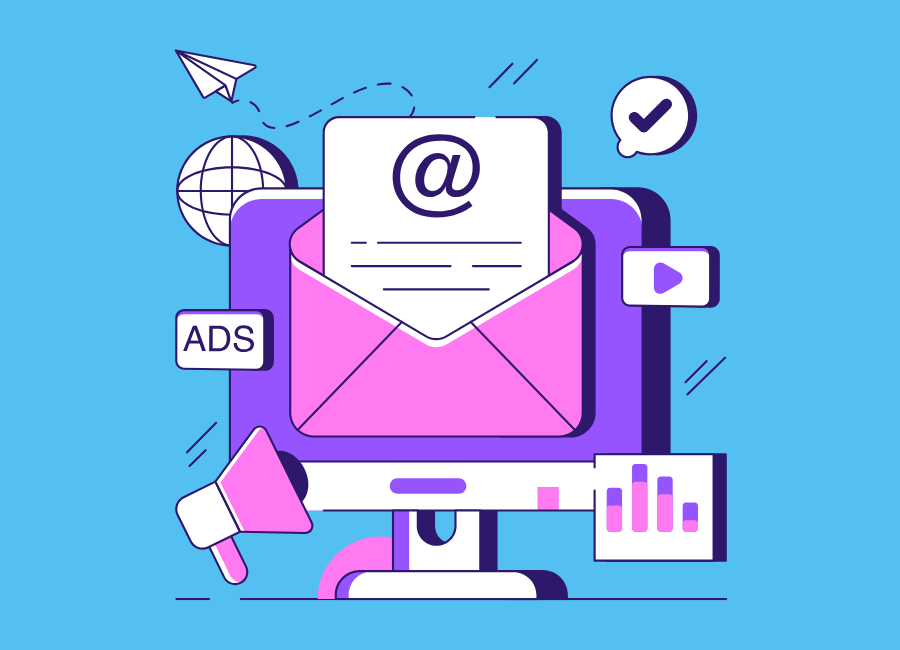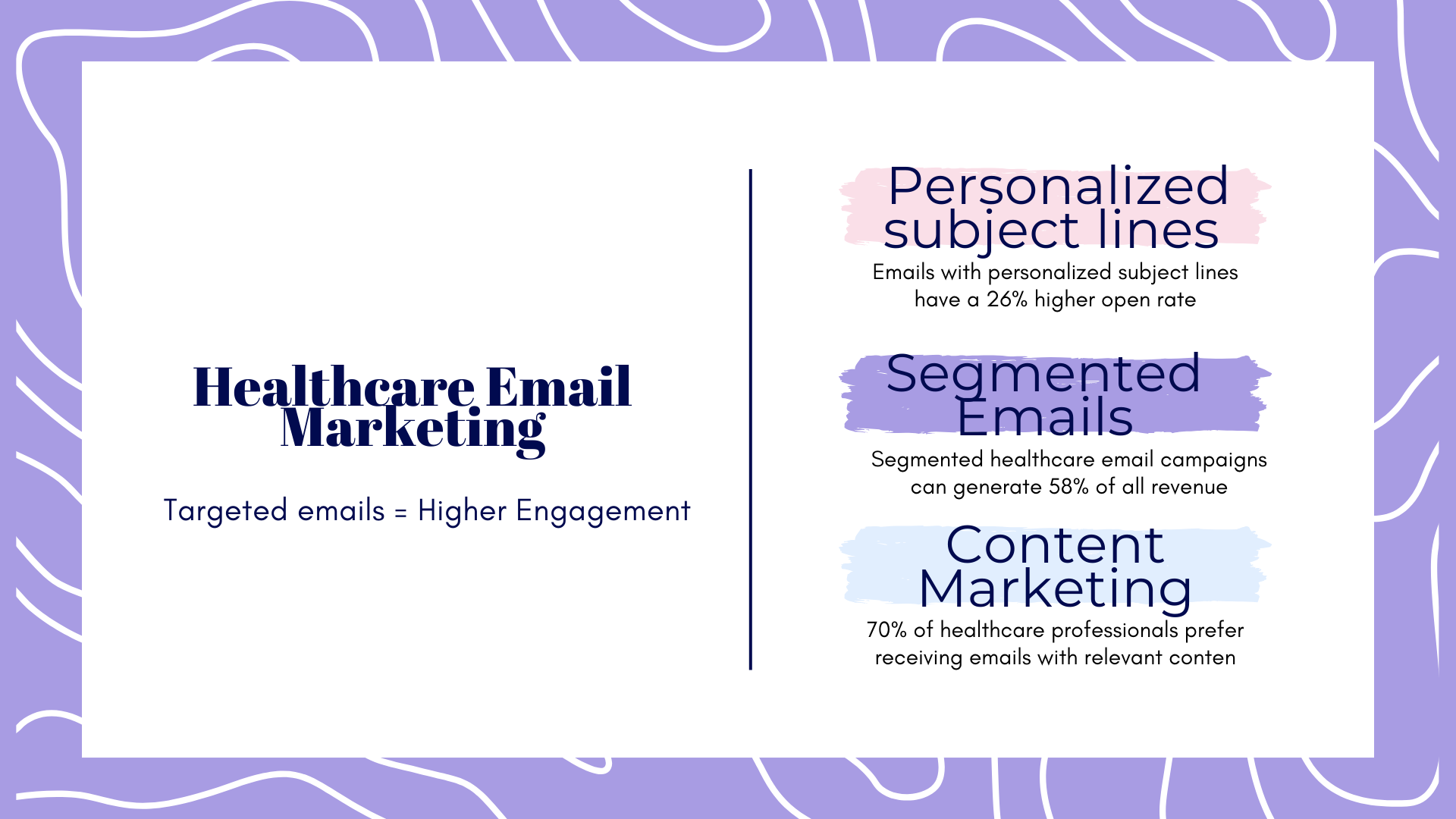Healthcare email marketing is unique because it deals with sensitive data and must comply with strict regulations. You must ensure your emails are accurate, relevant, and personalized to build trust and maintain compliance.

TABLE OF CONTENTS
Healthcare email marketing requires precision and compliance, setting it apart from typical B2B marketing. This blog covers key strategies to boost your email campaigns in the healthcare sector.
Learn how to segment your audience by role, specialty, and behavior to improve targeting and relevance. We also highlight the importance of personalization, using data insights, A/B testing, and behavior-based triggers to enhance engagement.
The blog also emphasizes using verified email lists and trusted data providers, ensuring you reach the right C -level executives while maintaining compliance. It’s a comprehensive guide for healthcare marketers looking to optimize their email campaigns legally and ethically.

1. Why Does Healthcare Outreach Demand a Specialized Email Strategy?
Healthcare outreach requires a specialized email strategy due to the sensitive nature of medical data and strict regulations like HIPAA and GDPR. Marketers must deliver tailored, compliant content to various healthcare professionals, ensuring personalization, privacy, and relevance. Proper targeting and segmentation are key to achieving effective, trust-building communication.
1.1. Building a High-Quality, Compliant Data
Effective healthcare email marketing begins with a clean, accurate, and compliant data. Healthcare marketers must ensure all data complies with privacy and data security standards. Reaching the right professionals starts with high-quality data.
1.2. Why Verified Healthcare Data Matters
Verified healthcare data is essential for B2B email marketing. Without it, your campaigns risk targeting the wrong audience, resulting in low engagement and wasted resources.
Accurate, up-to-date data ensures your emails reach the right decision-makers, boosting ROI and maintaining compliance.
1.3. Choosing the Right Data Provider
Choosing the right B2B data provider for your email marketing strategy ensures precision and success. Look for a provider offering verified, compliant, and up-to-date healthcare data. This ensures your emails reach the right decision-makers, boosting engagement, conversion rates, and campaign ROI.
For targeted healthcare outreach, providers like MedicoLeads offer specialized data solutions that meet these criteria.
Struggling with inaccurate contacts?
Boost your campaign's success with verified healthcare data. Are you ready to get started?
Request FREE Sample List1.4. Safe List-Building Tactics
To build a compliant contact list, use opt-in methods to ensure explicit consent. Segment healthcare providers by specialty or role for targeted outreach. Regularly clean your list to remove inactive contacts and maintain high deliverability.
Pro-tip: Focus on permission-based, high-intent contacts over list size.
2. Crafting Personalized and Relevant Email Content
Personalization in healthcare email marketing goes far beyond using a first name. It’s about delivering role-specific, specialty-focused content that resonates with busy professionals. Relevance drives trust and higher engagement.
2.1. How to Segment Healthcare Professionals
To segment healthcare professionals for email marketing, categorize them based on factors like specialty, role, location, and practice size. Use behavioral data, such as past interactions or content preferences, to create personalized messaging that resonates with each group.
You can segment your audience based on:
- Role: Physician, nurse, administrator
- Specialty: Cardiology, oncology, pediatrics
- Institution type: Hospital, clinic, private practice
- Region and seniority level
Tailored content ensures your message reaches the right person at the right time.
2.2. Using Data to Enhance Personalization
Use data to enhance email personalization by analyzing open rates, clicks, and content preferences. Trigger automated emails based on user behavior and run A/B tests for optimized subject lines and CTAs. Personalize messaging by specialty, interests, and actions for higher engagement.
3. Ensuring Compliance with Healthcare Regulations
Compliance is the cornerstone of successful healthcare email marketing. Data regulations dictate how you collect, store, and use personal health data. Non-compliance can lead to significant fines, reputational damage, and loss of trust from your audience. Understanding these rules and adhering to them ensures your campaigns are legally sound, secure, and trustworthy.
3.1. Key Compliance Guidelines
Following data regulations is essential to ensure that B2B data privacy, and trust. Here’s a brief overview of the key guidelines you must follow to stay compliant and avoid legal risks.
- Use data compliant email platforms for any Protected Health Information (PHI)
- Get explicit consent before sending marketing emails
- Avoid pre-checked boxes and ensure clear opt-in methods
- Include visible unsubscribe links in every email
- Maintain logs of consent and data usage
3.2. Tools to Support Compliance
To maintain compliance, healthcare marketers need to use specialized tools that protect sensitive data and ensure ethical marketing practices. These tools not only help you meet legal requirements but also minimize the risk of violations. Here’s how you can leverage them:
- Use secure email services like Paubox or Hushmail
- Implement consent management tools
- Perform regular list cleaning and validation
- Train staff on privacy and email marketing laws
4. Maximizing Engagement Through Multi-Touch Campaigns
Multi-channel campaigns are key to boosting engagement in healthcare email marketing. By interacting with your audience across multiple channels and touchpoints, you create more opportunities for connection and trust-building.
Here’s how to optimize your approach:
- Personalized Outreach: Use data-driven insights to personalize messages and increase relevance.
- Multi-Channel Integration: Combine email with other channels like SMS, social media, or paid ads for more visibility.
- Consistent Messaging: Ensure your messaging aligns across all channels, reinforcing your value proposition.
- Follow-Up Sequences: Implement automated follow-up emails based on user actions to maintain engagement.
These strategies help healthcare marketers engage decision-makers at different stages, ultimately driving conversions and increasing ROI.
5. Measuring Success and Optimizing Performance
Tracking performance is crucial to continuously refining your healthcare email marketing strategy. By focusing on key metrics, you can evaluate the effectiveness of your campaigns and optimize them for improved results.
Here are the essential metrics you should monitor:
- Open Rates & Click-Through Rates (CTR): Monitor these to evaluate the appeal and relevance of your subject lines and content.
- Conversion Rate: Track how many recipients take the desired action after receiving your email, whether it’s signing up or making a purchase.
- Bounce Rates: Keep an eye on hard and soft bounces to ensure your list is clean and your emails are being delivered.
- Engagement Over Time: Evaluate how your audience interacts with emails over weeks or months to spot trends.
- A/B Testing Results: Run tests on subject lines, CTAs, and email designs to continually improve performance.
By focusing on these metrics, you can optimize your campaigns, ensuring better engagement, higher conversions, and improved ROI.
6. Conclusion: Smarter Email Strategies for Healthcare Marketers
In conclusion, healthcare email marketing requires compliance, personalization, and precision. By using segmentation, behavioral triggers, and best practices, you can engage healthcare professionals while staying compliant.
Partnering with MedicoLeads ensures you reach the right audience and supports multi channel Marketing also.
These strategies will help boost engagement and drive ROI.
Ready to boost your healthcare email marketing? Partner with MedicoLeads for verified, role-specific data that ensures compliance and maximizes engagement. Start reaching the right decision-makers today!
FAQs
Is email marketing effective for doctors?
Yes. Doctors prefer email for receiving valuable and relevant clinical information. Personalized, compliant emails that deliver useful content can engage physicians and other healthcare providers to help build long-term relationships.
Can I send promotional emails without consent?
No. Sending emails without consent violates key laws such as GDPR and HIPAA. Always use opt-in lists to ensure you’re complying with legal requirements and maintaining your reputation.
How do I personalize emails for medical roles?
Segment your list by role (e.g., doctors, administrators), specialty (e.g., cardiology), location, and other factors. This ensures that each healthcare professional receives content relevant to their job, making it more likely to engage with your message.
What type of content gets the best response?
Educational content such as whitepapers, case studies, and webinars tends to perform best. Avoid overtly promotional content—focus on providing value, and trust will follow.
How often should I email healthcare contacts?
Sending 2–4 emails per month is ideal. Using behavior-based triggers and drip campaigns ensures you stay top-of-mind without overwhelming recipients.
Why do my emails bounce in healthcare lists?
Bounces often happen due to outdated or inaccurate data. Use verified, up-to-date healthcare email lists from trusted providers to ensure better deliverability and engagement.
How can I measure healthcare email success?
Track metrics like open rates, CTR, conversion rates, and unsubscribes. Pair these with CRM data to understand the impact of your campaigns on lead generation, conversions, and ROI.
How do I grow a compliant email list?
Grow your email list through gated content, opt-in forms, and webinars. Never buy unverified lists. Always log consent, follow regulations, and ensure recipients have agreed to receive your emails.
What’s a GDPR-compliant email list?
A GDPR-compliant list requires explicit, informed consent, usually through double opt-in forms. It also involves offering easy opt-out options and maintaining clear data management practices.
How do I segment emails?
Effective segments include:
- Role (e.g., physicians, administrators)
- Specialty (e.g., oncology, pediatrics)
- Geography (e.g., clinics in New York)
- Behavior (e.g., webinar attendees)
Segmenting ensures you send the most relevant content, improving engagement.
Which metrics matter most in email campaigns?
Focus on open rate, click-through rate, conversions, deliverability, and unsubscribe rates. Use insights to refine targeting and messaging.
Contact Us

